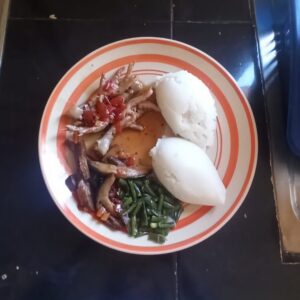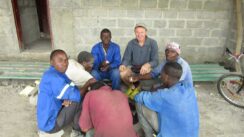Discover the Diverse and Flavorful World of Zambian Cuisine: A Culinary Adventure Awaits!

The diversity of Zambian cuisine and its cultural influences
Zambia is known for its diverse cuisine, influenced by its various ethnic groups and cultures. Traditional Zambian dishes often feature ingredients such as maize, cassava, beans, peanuts, and various types of meat, including beef, chicken, and fish. The country’s cuisine offers unique and delicious dishes that genuinely reflect Zambia’s rich cultural heritage.
Nshima, a staple food made of maize meal
Nshima is a staple food commonly consumed in Zambia, Malawi, and other southern African countries. It is made of maize meal cooked in hot water until it becomes a thick porridge-like consistency. Nshima is traditionally eaten with the hands, using small balls of the mixture to scoop up stews, vegetables, and other dishes.
Nshima is a popular food for several reasons
- It is very filling and provides a good source of energy.
- It is relatively cheap and easy to make, making it accessible to a wide range of people.
- It is often seen as a symbol of national and cultural identity and is deeply ingrained in the social fabric of many southern African communities.
Overall, nshima is an essential and beloved part of the cuisine and culture of this region.
How Nshima is eaten with various relishes such as fish, meat, or vegetables… even with chicken claws
When eating Nshima, it is common to use one’s hands to roll the maize meal into small balls, which are then used to scoop up the relish. The relishes can be prepared in various ways, depending on the ingredients used. Fish relishes, for example, may be made by simmering fish with tomatoes, onions, and other spices, while meat relishes may be made by stewing beef or chicken with vegetables and herbs. Vegetable relishes can also be made by cooking diverse vegetables, such as cabbage, rape, beans or pumpkin leaves, or cassava leaves.
Overall, Nshima is a versatile and satisfying meal that can be enjoyed with various relishes. Whether you prefer fish, meat, or vegetables, there is a relish that is sure to please your taste buds. So the next time you’re in Zambia or Malawi, be sure to give Nshima a try!
Other popular Zambian dishes Ifisashi, Kapenta, and Chikanda
As mentioned above, Zambia has a rich culinary culture with a variety of traditional dishes enjoyed by locals and visitors alike.
Ifisashi
One of these dishes is ifisashi, a popular Zambian dish made from groundnuts, spinach, and other vegetables. This dish is often served with nshima.
Kapenta
Another popular Zambian food is Kapenta, made from small freshwater fish found in Lake Tanganyika. The fish are sun-dried and then cooked with vegetables and spices to create a delicious meal. Kapenta is typically served with nshima.
Chikanda
Chikanda, often called African polony, is another popular Zambian dish made from groundnuts and wild orchid tubers. The tubers are peeled, boiled, and then mashed with groundnuts to create a dough-like texture. The dough is then shaped into balls and boiled before being served with vegetables or meat. Chikanda has a unique taste and is a popular street food in Zambia.
If you ever get the chance to visit Zambia, be sure to try these popular dishes and experience the unique flavors of Zambian cuisine.
Zambian Street Food
There are a few popular street food dishes that you might want to try. One of them is fried caterpillars, which are exactly what they sound like – caterpillars that have been fried up until they’re crispy and crunchy.
Another option is kapenta, a type of small fish that’s often dried and then fried or grilled.
Finally, there’s roasted maize, which is simply corn on the cob that’s been grilled or roasted until it’s tender and slightly charred. All three of these dishes are considered local treats in their respective regions, and they’re definitely worth a try if you’re feeling adventurous!
Zambian Drinks
Munkoyo
Munkoyo is a refreshing and delicious traditional Zambian drink that is made from maize meal and water. This is a popular beverage that many locals in Zambia enjoy, and it is known for its sweet, tangy, and slightly sour taste. Munkoyo is a must-try for anyone visiting Zambia who wants to experience the local culture and cuisine. It is usually served cold and is a perfect drink to cool you down on a hot day. Munkoyo is not only tasty but also nutritious, as it is rich in vitamins and minerals that are essential for good health. Overall, Munkoyo is a delightful drink that is sure to satisfy your taste buds and leave you feeling refreshed and invigorated.
Maheu
In Zambia, Maheu is a well-known and widely available traditional beverage. It’s typically sold in small, pre-packaged servings that are less than half a liter in size. The distinct color and flavor of Maheu are derived from its primary ingredient, finger millet, although other types of cereal or corn flour can be used as a substitute.
Chibuku Shake Shake
In addition to the refreshing and delicious traditional drink Munkoyo, Zambia is known for its popular alcoholic beverage, Chibuku Shake Shake. This fermented sorghum drink is a favorite among locals and is enjoyed by many. With its unique taste and slightly sour flavor, Chibuku Shake Shake is a must-try for anyone who wants to experience the local culture and cuisine. This popular drink is often served cold and is a perfect choice for those looking for a refreshing way to cool down on a hot day. Not only is Chibuku Shake Shake a tasty beverage, but it is also known for its nutritional value, as it is rich in vitamins and minerals that are essential for good health. If you are looking for a delightful and invigorating drink to try in Zambia, Chibuku Shake Shake is definitely worth a try!
Mosi beer and Castle beer
Another popular beverage in Zambia is Mosi beer, which is a locally brewed lager that is enjoyed by many. With its crisp taste and refreshing flavor, Mosi beer is a great choice for those looking for a cold and satisfying drink. Castle beer is another well-known beer in Zambia, and it is a popular choice among locals and tourists alike. This beer is known for its smooth and rich taste, and it is perfect for those who enjoy a full-bodied brew. Whether you are looking for a light and refreshing beer or a more robust and flavorful option, Zambia has a wide variety of beers to choose from. So, why not try Mosi beer or Castle beer and experience the flavors of Zambia for yourself?
Conclusion
Zambian cuisine is a diverse and flavorful combination of traditional African dishes and influences from neighboring countries. The cuisine varies depending on the region, with staple foods like maize, cassava, and yams forming the base of many dishes. Meat dishes are also popular, including grilled or stewed goat, chicken, and beef. Zambian cuisine also features a variety of vegetables and fruits, including pumpkin leaves, okra, and mangoes. Some popular dishes include nshima, a maize-based porridge served with vegetables and meat, and Ifisashi, a peanut-based stew. Zambian cuisine is an important part of the country’s cultural heritage and represents the diverse and rich history of the region. And let’s not forget about the beverages! Zambian cuisine features a diverse range of drinks, including locally brewed beers, Chibuku, or Munkoyo and Maheu.
If you’re a foodie looking to try something new and exciting, Zambian cuisine is definitely worth exploring. The country’s diverse culinary traditions make for a truly unique dining experience. From nshima (a staple dish made from maize flour) to grilled tilapia and delicious stews, there are plenty of dishes to try that will tantalize your taste buds. So if you’re up for a culinary adventure, give Zambian food a try and discover the delicious flavors of this fascinating country!
© Copyright 2023 | All Rights Reserved | Culture, education and computing in Africa z.s. | ID: 17334403| Hnojice 130, 785 01, Czechia












